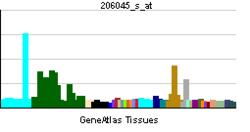- NOL4
-
Nucleolar protein 4 Identifiers Symbols NOL4; CT125; NOLP External IDs OMIM: 603577 MGI: 2441684 HomoloGene: 36142 GeneCards: NOL4 Gene Gene Ontology Molecular function • RNA binding Cellular component • nucleus
• nucleolusSources: Amigo / QuickGO RNA expression pattern 
More reference expression data Orthologs Species Human Mouse Entrez 8715 319211 Ensembl ENSG00000101746 ENSMUSG00000041923 UniProt O94818 P60954 RefSeq (mRNA) NM_001198546.1 NM_199024 RefSeq (protein) NP_001185475.1 NP_950189 Location (UCSC) Chr 18:
31.43 – 31.8 MbChr 18:
22.85 – 23.2 MbPubMed search [1] [2] Nucleolar protein 4 is a protein that in humans is encoded by the NOL4 gene.[1][2]
References
- ^ Ueki N, Kondo M, Seki N, Yano K, Oda T, Masuho Y, Muramatsu M (Dec 1998). "NOLP: identification of a novel human nucleolar protein and determination of sequence requirements for its nucleolar localization". Biochem Biophys Res Commun 252 (1): 97–102. doi:10.1006/bbrc.1998.9606. PMID 9813152.
- ^ "Entrez Gene: NOL4 nucleolar protein 4". http://www.ncbi.nlm.nih.gov/sites/entrez?Db=gene&Cmd=ShowDetailView&TermToSearch=8715.
Further reading
- Bonaldo MF, Lennon G, Soares MB (1997). "Normalization and subtraction: two approaches to facilitate gene discovery.". Genome Res. 6 (9): 791–806. doi:10.1101/gr.6.9.791. PMID 8889548.
- Ueki N, Oda T, Kondo M et al. (1999). "Selection system for genes encoding nuclear-targeted proteins". Nat. Biotechnol. 16 (13): 1338–42. doi:10.1038/4315. PMID 9853615.
- Strausberg RL, Feingold EA, Grouse LH et al. (2003). "Generation and initial analysis of more than 15,000 full-length human and mouse cDNA sequences". Proc. Natl. Acad. Sci. U.S.A. 99 (26): 16899–903. doi:10.1073/pnas.242603899. PMC 139241. PMID 12477932. http://www.pubmedcentral.nih.gov/articlerender.fcgi?tool=pmcentrez&artid=139241.
- Ota T, Suzuki Y, Nishikawa T et al. (2004). "Complete sequencing and characterization of 21,243 full-length human cDNAs". Nat. Genet. 36 (1): 40–5. doi:10.1038/ng1285. PMID 14702039.
- Gerhard DS, Wagner L, Feingold EA et al. (2004). "The Status, Quality, and Expansion of the NIH Full-Length cDNA Project: The Mammalian Gene Collection (MGC)". Genome Res. 14 (10B): 2121–7. doi:10.1101/gr.2596504. PMC 528928. PMID 15489334. http://www.pubmedcentral.nih.gov/articlerender.fcgi?tool=pmcentrez&artid=528928.
- Rual JF, Venkatesan K, Hao T et al. (2005). "Towards a proteome-scale map of the human protein-protein interaction network". Nature 437 (7062): 1173–8. doi:10.1038/nature04209. PMID 16189514.
- Kimura K, Wakamatsu A, Suzuki Y et al. (2006). "Diversification of transcriptional modulation: Large-scale identification and characterization of putative alternative promoters of human genes". Genome Res. 16 (1): 55–65. doi:10.1101/gr.4039406. PMC 1356129. PMID 16344560. http://www.pubmedcentral.nih.gov/articlerender.fcgi?tool=pmcentrez&artid=1356129.
- Tsang HT, Connell JW, Brown SE et al. (2006). "A systematic analysis of human CHMP protein interactions: additional MIT domain-containing proteins bind to multiple components of the human ESCRT III complex". Genomics 88 (3): 333–46. doi:10.1016/j.ygeno.2006.04.003. PMID 16730941.
Categories:- Human proteins
- Chromosome 18 gene stubs
Wikimedia Foundation. 2010.
